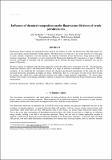| dc.contributor.author | Ryder, Alan G. | |
| dc.contributor.author | Glynn, Thomas J. | |
| dc.contributor.author | Feely, Martin | |
| dc.date.accessioned | 2016-01-25T15:19:49Z | |
| dc.date.available | 2016-01-25T15:19:49Z | |
| dc.date.issued | 2003 | |
| dc.identifier.citation | Ryder, A.G.; Glynn, T.J.; Feely, M.; (2003) 'Influence of chemical composition on the fluorescence lifetimes of crude petroleum oils' Proc SPIE - Int. Soc. Opt. Eng, 4876 :1188-1195. | en_IE |
| dc.identifier.issn | 1996-756X | |
| dc.identifier.uri | http://hdl.handle.net/10379/5495 | |
| dc.description.abstract | Fluorescence based methods are increasingly being used for the analysis of crude oils because they offer high speed, low
cost, non-contact, and non-destructive testing options. The fluorescence of crude oils is due to the presence of a wide range of cyclic aromatic compounds, with the intensity and temporal behaviour of this fluorescence being directly related to chemical composition. In particular, we have found that the Fluorescence Lifetime (FL) measured at a range of different
emission wavelengths is correlated with the concentrations of the aromatic and polar fractions of petroleum oils, and the
density (API gravity).
We have analyzed 22 different crude oils from around the world with API gravities of between 10 to 50. The fluorescence
steady-state emission spectra and fluorescence lifetimes at a range of emission wavelengths were measured for 380 nm
excitation. It was found that the correlations between the chemical and physical characteristics of the crude oils and the measured fluorescence parameters are highly non-linear. Furthermore, there is a wide degree of scatter in the observed data for medium oils, which have similar physical properties but widely varying chemical compositions. We discuss these
findings in the context of developing quantitative methods of analysis for crude petroleum oils based on fluorescence lifetime measurements. | en_IE |
| dc.description.sponsorship | Enterprise Ireland Research Innovation Fund award (IF/2001/061) and a Millennium Research Fund grant (MF9/98/M) from NUI-Galway. | en_IE |
| dc.format | application/pdf | en_IE |
| dc.language.iso | en | en_IE |
| dc.publisher | Society of Photo-optical Instrumentation Engineers | en_IE |
| dc.relation.ispartof | Proc SPIE - Int. Soc. Opt. Eng. | en |
| dc.rights | Attribution-NonCommercial-NoDerivs 3.0 Ireland | |
| dc.rights.uri | https://creativecommons.org/licenses/by-nc-nd/3.0/ie/ | |
| dc.subject | Fluorescence | en_IE |
| dc.subject | API gravity | en_IE |
| dc.subject | Lifetime | en_IE |
| dc.subject | Petroleum | en_IE |
| dc.subject | Asphaltene | en_IE |
| dc.subject | Sulphur | en_IE |
| dc.subject | Aromatic | en_IE |
| dc.subject | Chemistry | en_IE |
| dc.subject | Physics | en_IE |
| dc.subject | Geology | en_IE |
| dc.title | Influence of chemical composition on the fluorescence lifetimes of crude petroleum oils | en_IE |
| dc.type | Article | en_IE |
| dc.date.updated | 2015-12-22T15:21:32Z | |
| dc.identifier.doi | doi:10.1117/12.463915 | |
| dc.local.publishedsource | http://proceedings.spiedigitallibrary.org/proceeding.aspx?articleid=879165 | en_IE |
| dc.description.peer-reviewed | Not peer reviewed | |
| dc.contributor.funder | |~|1267880|~|1267869|~| | |
| dc.internal.rssid | 1158893 | |
| dc.local.contact | Alan Ryder, School Of Chemistry, Room 213, Arts/Science Building, Nui Galway. 2943 Email: alan.ryder@nuigalway.ie | |
| dc.local.copyrightchecked | No | |
| dc.local.version | ACCEPTED | |
| nui.item.downloads | 377 | |


